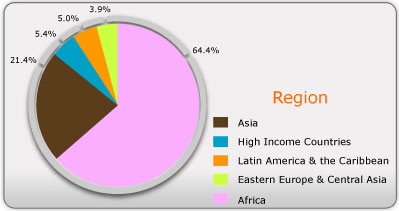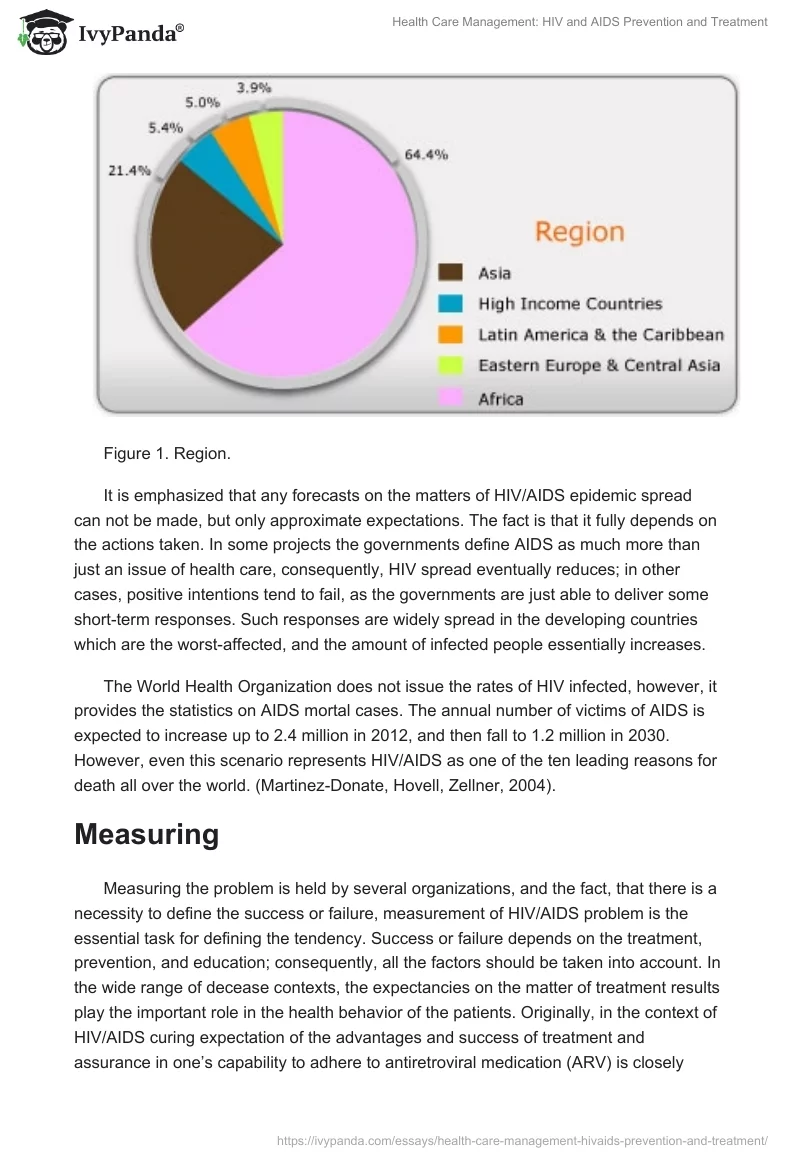Introduction
To define the measurement system, and define the failure or success of HIV/AIDS treatment it is necessary to give the image of the situation in general. By the estimations from the UNAIDS 2008 Report on the global AIDS epidemic, nearly 30.8 million adults and 2 million children had HIV at the end of 2007. Unfortunately, the data on the later periods is not available, however, it is hardly probable that these rates have decreased by the present time. Globally, the statistics are the following: nearly 11% are babies who get infections from their mothers. 10% – injecting drug users, 5 – 10% get an infection because of homosexual contacts, the same rate is for medical carelessness, and the rest proportion (two-thirds of all infections) are caused by heterosexual contacts. (Potter, 2008)
Originally, 95% of the infected people are from the developing world and the Third World Countries. And the proportion tends to increase even faster than the common proportion of infected vs. uninfected due to poor medication, limited resources for prevention and care.

It is emphasized that any forecasts on the matters of HIV/AIDS epidemic spread can not be made, but only approximate expectations. The fact is that it fully depends on the actions taken. In some projects the governments define AIDS as much more than just an issue of health care, consequently, HIV spread eventually reduces; in other cases, positive intentions tend to fail, as the governments are just able to deliver some short-term responses. Such responses are widely spread in the developing countries which are the worst-affected, and the amount of infected people essentially increases.
The World Health Organization does not issue the rates of HIV infected, however, it provides the statistics on AIDS mortal cases. The annual number of victims of AIDS is expected to increase up to 2.4 million in 2012, and then fall to 1.2 million in 2030. However, even this scenario represents HIV/AIDS as one of the ten leading reasons for death all over the world. (Martinez-Donate, Hovell, Zellner, 2004).
Measuring
Measuring the problem is held by several organizations, and the fact, that there is a necessity to define the success or failure, measurement of HIV/AIDS problem is the essential task for defining the tendency. Success or failure depends on the treatment, prevention, and education; consequently, all the factors should be taken into account. In the wide range of decease contexts, the expectancies on the matter of treatment results play the important role in the health behavior of the patients. Originally, in the context of HIV/AIDS curing expectation of the advantages and success of treatment and assurance in one’s capability to adhere to antiretroviral medication (ARV) is closely linked with obedience, which is associated with clinical outcome. (Fernandez, Bowen, Gay, 2003).
There is a powerful concern, which is closely linked with the belief that curing may complicate the spread of HIV. The education may prevent HIV positive to get sexually engaged with those who are not infected, and HIV negative will be more careful while making sex with those whose HIV status is unknown.
To study all these factors it is necessary to measure treatment expectations and perspectives carefully, thoroughly, and accurately, as measures used for previous researches were either concentrated on decease progression, without taking into account the treatment expectations or were not held based on accepted standards. (Seal, Ehrhardt, 2004).
Understanding the mechanisms of HIV transmission is important for the evaluation of the prevention measures, and, consequently for measuring the success. The doctors of the developed countries generally tell their patients how HIV is transmitted, and what can be done to prevent infecting others. The high-risk behaviors should be discussed. These talks relate to the issues of education, consequently, the higher the education level – the lower the risks for infection, the lower infection rates, and mortalities.
Measurement factors should also entail the worldwide use of prevention tools, medications, and contraceptives. Only by taking into account these factors, we may get the correct and accurate evaluation of the problem.
Prevention and Treatment
Originally, prevention does not mean treatment, as it is aimed to avoid infection, but not to cure it. Prevention is achieved by several means: education is the basic, however, it is impossible to find out the rates of HIV/AIDS prevention education, and it is known, that there is no opportunity to educate people in the Third World countries, and they do not know whether they are infected, and how can they prevent infecting the others. (Vernon, 2005).
Using prevention strategies, such as condoms and safer sex practices helps to decrease the risks. Sharing a syringe with other addicts essentially increases the risk of HIV transmission.
Successful treatment can lower the viral way and essentially decrease the risk of HIV transmission. However, there are obstacles and factors, which increase these risks. These are:
- presence of other sexually transmitted diseases (STDs)
- genital irritation
- menstruation
- lack of circumcision in men
- taking birth control pills
- hormone imbalances
- vitamin and mineral deficiencies
Unfortunately, despite effective educational campaigns in the developed countries, the developing states experience an essential lack of educators, consequently, the rates of HIV infected grow, and the proportion of infected, mentioned in the introduction, will tend to increase until the there powerful educational base is created. (Holmes, 2003).
Evaluation
Estimation of the costs and efforts spent for HIV/AIDS prevention and treatment is regarded to be critical for effective resource appointments and efficient, thoroughly arranged care for infected people. The evaluation process is essentially complicated because of the fragmented public support, maintenance by private, and non-governmental organizations, the essential lack of a sufficient health care infrastructure, and the irregularity of perspective when measuring and evaluating costs and efforts.
Conclusion
Measuring success or failure in the problem of HIV prevention and infection is a difficult task due to several factors. These factors are the uncontrolled spread of the infection, insufficient educational base in the regions with increased HIV infection rates, and lack of qualified help and care for those who are infected. Originally, the allover process of HIV prevention can not be regarded as successful because of the well-known factors and problems.
Small successes in prevention and education are undoubtedly helpful; however, they look tiny on the background of the scales of the allover problem. Anyway, the accurate measurement is impossible, and the allover image is unknown, consequently, there will be no effective and unified measurement of this hazard, however, the success will be measured taking into account the percent of infected, educated, cared, and prevented.
References
- Economic and Social Commission for Asia and the Pacific. (2003). HIV/AIDS Prevention, Care, and Support: Stories from the Community. New York: United Nations.
- Emmers-Sommer, T. M., & Allen, M. (2005). Safer Sex in Personal Relationships: The Role of Sexual Scripts in HIV Infection and Prevention. Mahwah, NJ: Lawrence Erlbaum Associates.
- Fernandez, M. I., Bowen, G. S., Gay, C. L., Mattson, T. R., Bital, E., & Kelly, J. A. (2003). HIV, Sex, and Social Change: Applying ESID Principles to HIV Prevention Research. American Journal of Community Psychology, 32(3-4), 333
- Holmes, W. (2003). Protecting the Future: HIV Prevention, Care, and Support among Displaced and War-Affected Populations. Bloomfield, CT: Kumarian Press.
- Martinez-Donate, A. P., Hovell, M. F., Zellner, J., Sipan, C. L., Blumberg, E. J., & Carrizosa, C. (2004). Evaluation of Two School-Based HIV Prevention Interventions in the Border City of Tijuana, Mexico. The Journal of Sex Research, 41(3), 267
- Palmer, N. B. (2004). “Let’s Talk about Sex, Baby”: Community-Based HIV Prevention Work and the Problem of Sex. Archives of Sexual Behavior, 33(3), 271
- Potter, R. H. (2008, June). Evidence-Based HIV Prevention Programs for Correctional Settings: How Do You Know What Works?. Corrections Today, 70, 90
- Rosenberg, J. (2008). HIV Prevention Knowledge Linked to Paying for Sex. International Family Planning Perspectives, 34(2), 61.
- Seal, D. W., & Ehrhardt, A. A. (2004). HIV-Prevention-Related Sexual Health Promotion for Heterosexual Men in the United States: Pitfalls and Recommendations. Archives of Sexual Behavior, 33(3), 211
- Vernon, I. S. (2005). Killing Us Quietly: Native Americans and HIV/AIDS. Lincoln, NE: University of Nebraska Press.


